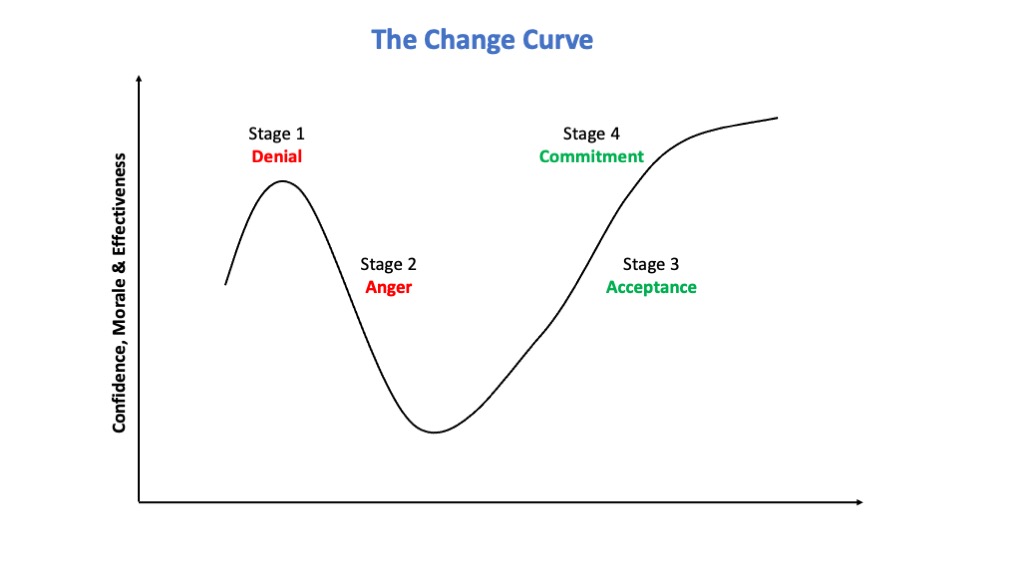The Change Curve is a popular and effective model for explaining the typical sequence of people’s reactions to change. This model is based on Elisabeth Kübler-five Ross’s stages of grief, which she developed in 1969. The Kübler-Ross model was designed to help people deal with death, but its application has since expanded to anyone dealing with major life changes.

This version of the Change Curve categorizes people’s reactions to change into four stages: denial, anger, acceptance, and commitment. If you are currently going through a major life change, the length of time it takes to successfully overcome this change is entirely up to you. Some people can move quickly from one stage to the next and adjust to changes in a short amount of time. Others may take longer to adjust to the change.
1. Denial
This is the first stage of the curve, which occurs when the individual becomes aware of the change. The initial reaction is to deny it, as he would rather believe that the change is not taking place. As the individual perceives the change as a threat to his status quo, he is prone to react negatively and blame others.
2. Anger
This is the curve’s second stage. At this point, the individual realizes that the change is real but is unable to see or find a way out, which often results in bitterness and anger. He will be stressed and may become stuck at this stage unless he is able to progress to the third stage.
3. Acceptance
The individual who has experienced denial and anger comes to accept the changes that have occurred in the third stage. This is the curve’s pivot point. Acceptance is a critical step because it enables one to understand why some changes are required, to become involved in these changes, and to learn to face them head on.
4. Commitment
This is the final stage of the curve, in which the individual maintains a commitment to work with others who assist him in accepting the change as it becomes clear that the change is permanent. At this point, he will attempt to devise practical methods for managing the change that has occurred.
Are you undergoing any changes in your life, either professionally or personally? If you are, what stage do you believe you are currently in?
To find out, follow these steps:
Step 1: Examine the Change Curve.
Step 2: Consider a situation in which you are confronted with change (s).
Step 3: Point to the stage you are currently at.
Step 4: Respond to the following questions:
- What brought me there?
- What is preventing me from progressing to the next stage?
- What would assist me in moving forward?
- What resources do I require to progress from one stage to the next?
Once you’ve answered these thought-provoking questions, you’ll be well on your way to managing this change. Being aware of where you are on the curve can be a very powerful tool for dealing with change.
It can be difficult to accept changes in our lives because we don’t know what our lives will be like after a significant change occurs. However, if we refuse to acknowledge the problem and take action, it will not improve. The only way out is to confront it and move on. It may be difficult at first, but you will become more adept at dealing with change over time.
“You must take personal responsibility. You cannot change the circumstances, the seasons, or the wind, but you can change yourself. That is something you have charge of.” – Jim Rohn
About the Author:
Terence Chiew is the Managing Director of Peet Asia and a Performance Consultant. He works with team leaders to develop high-performing teams and achieve organizational success through a variety of interventions such as personality and values assessments, performance consulting, leadership and management training, team building, and team alignment.
He is effectively bilingual (English and Mandarin) and a regular guest speaker on Singapore radio stations such as Jia FM 88.3, LIVE FM 93.8, CAPITAL FM 95.8, NOW FM 93.8, MONEY FM 89.3 and LOVE FM97.2 (Check out these recordings). He is the author of the book Most Valuable Professional: What Every Employee Ought to Know About Staying Employable and the winner of the Marketing Institute of Singapore’s ‘Best Personal Brand Award 2017’.
In terms of professional credentials, Terence is a Marshall Goldsmith Certified Executive Coach. Stakeholder Centered Coaching, Certified Team Coach by Marshall Goldsmith Stakeholder Centered Coaching, Certified Leadership Coach by Global Coach Group, Certified Team Coach by Global Coach Group, Certified Consultant for the Workplace Big Five Personality ProfileTM 4.0 Tool by Paradigm Personality Labs, LLC. (USA), Workplace Value ProfileTM 3.0 by Paradigm Personality Labs, LLC. Terence has a Specialist Diploma in Adult Learning and Teaching (SDALT), the Cambridge International Diploma for Teachers and Trainers (CIDTT), and the WSQ Advanced Certificate in Training and Assessment (ACTA). He is currently studying for an MSc in Marketing at the University of Salford (U.K.)






